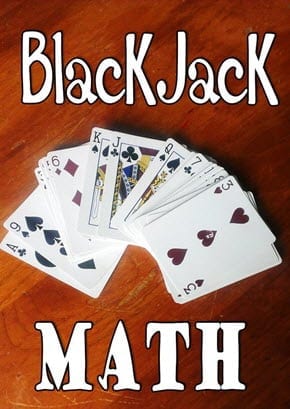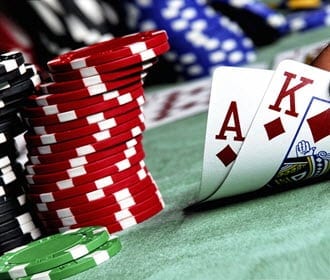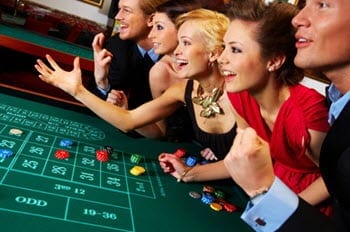The Mathematics of Gambling
The mathematics of gambling is the mathematics of probability. Even if you hated this subject at school or have even a basic knowledge of mathematics we urge you to pay careful attention to this section. Much of what we discuss on the other pages of this site will relate to the mathematics of gambling. We’ll cover odds and probability, the house edge, parlays and Bayes’ Theorem.
The mathematics of gambling is the mathematics of probability. Even if you hated this subject at school or have even a basic knowledge of mathematics we urge you to pay careful attention to this section. Much of what we discuss on the other pages of this site will relate to the mathematics of gambling. We’ll cover odds and probability, the house edge, parlays and Bayes’ Theorem.
Odds and probability
Gamblers and bookmakers express probability in terms of odds. The two terms mean essential the same thing. The odds of horse winning a race, or a football team beating the opposition, are the probabilities the bookmakers have decided that these events will occur. For example, let’s say that a horse in a race has odds of 4-1 (four to one), this means that bookmakers will expect the horse to win one 1 time for every 4 times it loses (in other words win once in every 5 attempts). Placing your initial stake on this winning event will get you a possibility of 1/5. To express this in terms of probability you simply add the two numbers together and place the total on the bottom of a fraction (the denominator) and the number of successes (the second number when looking at odds) on the top of the fraction (the numerator).
Some examples of conversion from odds to fractions are given below.
Odds |
Fraction |
|
| 4-1 (Four to One) | 1/5 | (1)/(4+1) |
| 9-2 (Nine to Two) | 2/11 | (2)/(9+1) |
| 7-4 (Seven to Four) | 4/11 | (4)/(7+4) |
| 6-4 (Six to Four) | 4/10 = 2/5 | (4)/(6+4) |
Once odds can be expressed as fractions we can also think of them as percentages. For example our 4-1 example becomes one fifth as a fraction, which corresponds to 20% (1 divided by 5 and then times 100). This means that the bookmakers think that there is a twenty percent change of the event occurring. It can sometimes be easier to think of odds and probabilities in terms of percentages. The ability to change odds to fractions and vice versa is a gambler’s skill every casino player should acquire.
The House Edge
You’ve probably heard heard it said the house (casino) has an edge at blackjack or craps or roulette, but what does it mean. Well let’s take the example of a coin toss. The true odds are 50/50, in other words there is a fifty percentage chance of heads and a fifty percentage chance of tails being the result of the coin toss.
This is called an even money shot and will have odds of 1-1 (even money). Remember from above that, expressed as a fraction, this will be 1/2, or one half. Let’s say you have 20 people who want to each bet on the result of your coin toss, and you offer them all even money or 1-1 on their wager. 10 people decide to bet heads and 10 decide to bet tails. The result is heads and you pay each person who bet heads (remember they win each and get their stake back). That’s you’ve paid out and you took in initial bets, you’ve made no money at all. Why not, we’ll you didn’t have a house edge. Let’s change the odds slightly, after all you’re the bookmaker and you can change the odds as you see fit. Let’s offer each person betting on the coin toss odds of 5-6 (five to six). That means for every six pounds they bet they’ll win (they actually get back their initial bet as will, so a bet will return in total). The 10 winners from the first example are back and flush with money ready to bet again and decide that they will bet each, five of them bet on heads and five bet on tails. The coin toss results in tails. You’ve collected a total of in bets on the event (10 times each punter’s stake) and have to pay out to each of five winners (that’s a total of ). As the book maker you’ve just made a profit of on the toss of a coin because you had the edge.
We’re all taught in schools that probabilities add up to 1. Well for bookmakers they don’t. Let’s break down our example above and see how you made money. The table bellow shows the odds, the fractions and the percentage chance you, as the bookmaker applied to the toss of a coin.
Outcome |
Odds |
Fractions |
Percentage |
| Head | 4-6 | 6/10 = 3/5 | 60% |
| Tail | 4-6 | 6/10 = 3/5 | 60% |
120% |
So the percentages added up to 120%. The amount over and above 100% is the bookmaker’s theoretical profit from this event. In this case the bookmakers could expect to make 20% on the toss of coin. If you think we’ve just made up this example and people would be mad to take odds of 4-6 on the toss of a coin you’re wrong. These are the exact odds offered by bookmakers on which team would win the coin toss at the start of the Superbowl in 2002. The house edge is 20%. The odds offered on an event are called the book (hence the term bookmakers) and we would sometimes say the bookmaker is running a 20% book. This, in essence, is the house edge. Almost all games have a house edge and because the casino’s and bookmaker’s set the odds they can decide how much of an advantage they have.
Parlays
A parley is when a gambler bets on the outcome of two or more events. Parlay tends to be used by Americans and can be more commonly referred to by European gamblers as doubles, trebles, accumulators etc. However, it is not just useful when looking at doubles and trebles.
In it’s simplest form lets imagine you are betting on the outcome of two horse races, Horse A in the first race and Horse B in the second race. Horse A is 6-4 and Horse B is 2-1. The method for calculating the probability that both these events will occur is to simply multiply them together. Remember from our examples on how to transfer odds to probabilities that 6-4 is 2/5 and 2-1 will be 1/3. If we multiply the fractions together (multiply the top numbers and the bottom numbers) we get…
2/5 * 1/3 = 2/15
So the answer is 2/15. Meaning that there is roughly a 13% chance that your bet will end up being a winner.
It is sometimes useful to calculate parlays in this way if a bookmaker is offering guaranteed odds in a parley. For example incorrect score & first goal scorer doubles. It can sometimes be to your advantage to place a standard bet rather than take the promotional offers available.
We won’t go into too much detail on parlays but some of the following examples will show you how they can be applied to differing events.
Example 1
What are the chances that heads will come up four times in four consecutive coin tosses (odds of heads are even money or 1-1).
1/2 * 1/2 * 1/2 * 1/2 = 1/16 (or 6.25%)
Example 2
What are the chances of being dealt two aces in a row from a shuffled deck of cards. This is a slightly more complicated parley, but not a difficult one. The probability of being dealt the first ace is 4/52 (4 aces in a total of 52 cards), and the probability of being dealt the second ace is 3/51 (3 aces left in a total of 51 cards). Therefore the calculation is.
4/52 * 3/51 = 12/2652 = 1/221 (or 0.45%)
Bayes’ Theorem
Ok so now we’re getting really heavy. Bayes’ Theorem is a very important and misunderstood part of probability theory. Bayes deals with the likelihood of an event occurring given that a related event has occurred. This is different from a parlay where the events may or may not be related. Here are a couple of examples of when the application of Bayes’ Theorem would be suitable in solving a probability problem
What are the chances that Chelsea will win the FA cup given that we know a London team will win it?
In a ten horse race there are three fillies (a,b and c), given that we know a filly won the race what is the probability that the filly a won?
The formula used to calculate these probabilities (and know as Bayes’ theorem) is..
Probability of event occurring by desired means
Total probability of event occurring at all
To get the point across let’s look at our Chelsea example. We’ll assume that there are eight teams left in the FA cup and they have the following percentage chances of winning.
Chelsea 8%
Arsenal 15%
Tottenham 10%
Newcastle 25% (So I’m a Newcastle Fan…..)
Sunderland 2%
Manchester Utd 15%
Leeds 10%
Southampton 15%
For those who don’t follow English football the three London teams are Chelsea, Arsenal and Tottenham. Applying these number to Bayes’ Theorem (above) we need to establish the probability of the event (ie Chelsea winning the FA cup) and the total probability of the event occurring at all (ie the probability that a London team win the cup). The first probability, the probability of Chelsea winning, is simply 8% (from the list above). The probability of a London team winning is similarly calculated. It is simply the probabilities of Chelsea winning, Arsenal winning and Tottenham winning added together. This will be 32% (8%+15%+10%). Bayes’ tells us that the probability of Chelsea winning the FA cup given that we know a London team will is 8%/32% which equals 25%. Personally I still think you should have bet on Newcastle.
We’re not going to bother with the fillies example as it’s exactly the same as the one above. Instead let’s imagine you have a double headed coin in your pocket. However, you also have four other coins of the same denomination. You take one coin out of your pocket, and without looking to see if it’s the double header toss it three times. You get three heads in a row. What are the chances you took out the double-headed coin? This example really gets to the heart of Bayes’ Theorem so, if you’re interested, pay attention.
The first probability we need to find is the probability of picking the double headed coin and tossing 3 heads in a row. This is a parlay. In the first part we must consider what is the probability of picking the double headed coin and then of tossing 3 heads with it. The answer is 1/5 (the probability of picking the double header) multiplied by 1 (the probability of tossing three heads in a row). We now have to consider the probability of picking a good coin and tossing three heads with it. The answer is 4/5 (being the chance of picking a good coin) multiplied by 1/2 x 1/2 x 1/2 (being the probability of throwing three heads in a row with it). The answer is 1/10.
Now we can apply or numbers to Bayes’ Theorem. The formula tell us that the probability will be…
Probability of event occurring by desired means
Total probability of event occurring at all
In this example the probability of the event occurring by desired mean is the probability of picking the double headed coin and tossing three heads…. we know this is 1/5.
The total probability of the event occurring at all is the probability that you will take a coin out of your pocket and toss three heads with it. The probability of picking the double headed coin and doing this is 1/5, and the probability of doing this with a normal coin is 1/10. To find the probability of doing this with any coin we simply add the two probabilities together….1/5 + 1/10 = 3/10. The answer to our Bayes’ Theorem problem is therefore (1/5)/(3/10) which equals 2/3 or 66%. In other words if you try this example and find you toss three heads in a row, there is a 66% chance you’ve picked up the double headed coin.
Well I think that’s enough hard probability work for now. In case you’re wondering what use Bayes’ Theorem is then try playing a bit of poker. You’re at the table against a very loose player and he likes to open with any pair. What are the chances he’s holding two pairs or better? With Bayes’ Theorem you can work out the exact probability (or odds) that he has the two pair or higher… Pretty clever eh?
HighRoller Casino Bonuses
| # | Casino | Rating | Bonus | Bonus Code | |
|---|---|---|---|---|---|
| 1 |  |
Read Review | Up to £/€/$1,000 + 200 Free Spins | Use Link | Visit |
| 2 |  |
Read Review | 100% Up To £100 Bonus | CASINO100 | Visit |
| 3 |  |
Read Review | $30 Free | WINBLACK | Visit |
| 4 |  |
Read Review | 200% up to €1000 + 100 FS | Use Link | Visit |
| 5 |  |
Read Review | 25 Free Spins | LIBRE25 | Visit |
| 6 |  |
Read Review | €1000 in welcome bonuses | Use Link | Visit |
| 7 |  |
Read Review | Willkommens bonus bis zu 1.000€ | Use Link | Visit |











